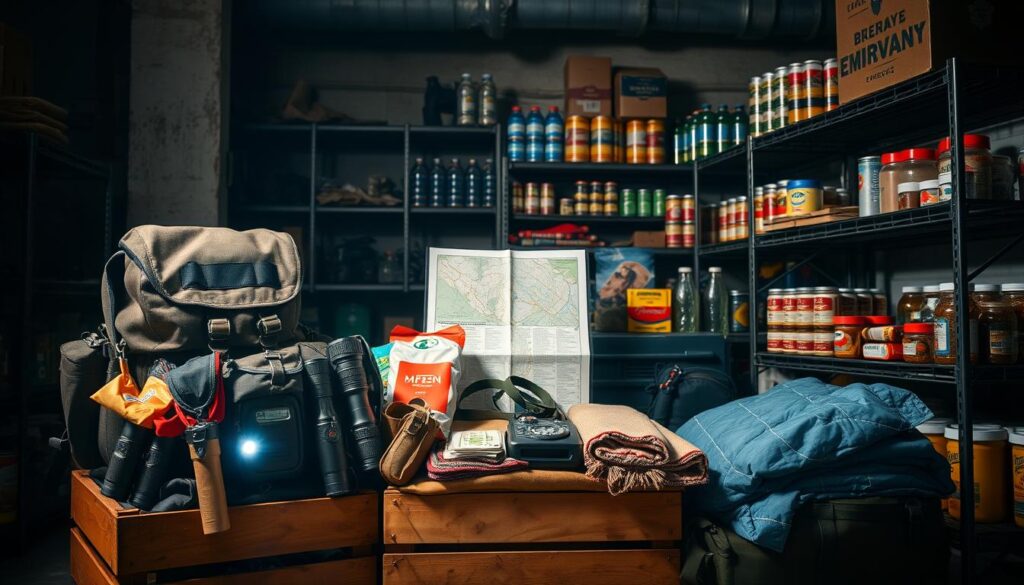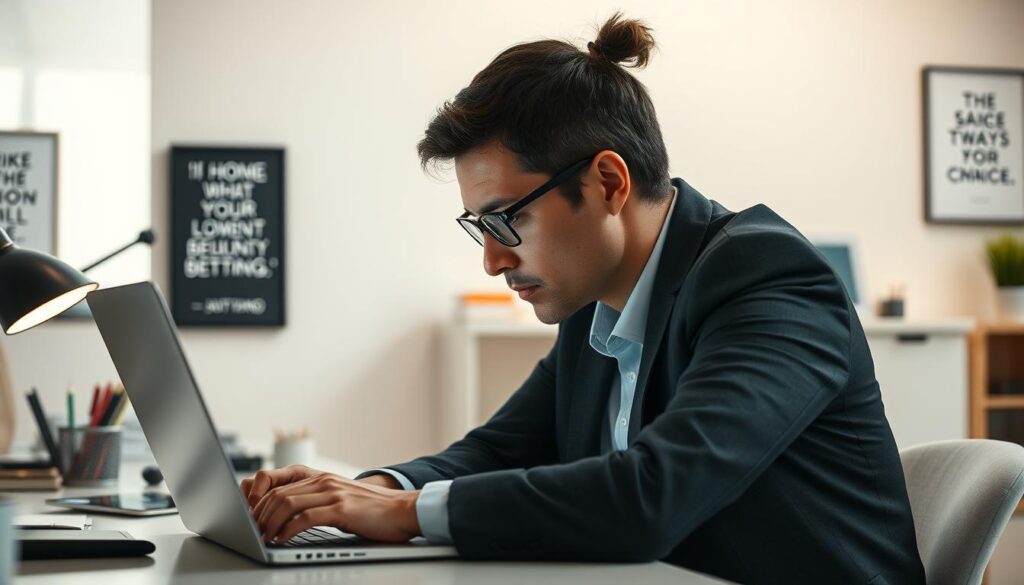Being ready for the unexpected is key for our safety and well-being. Creating a plan and practicing it can be a lifesaver in a crisis.
A strong emergency planning strategy can lower the risk of injury or property loss. It’s vital to prepare for possible disasters. I’m here to help you through this process.
Key Takeaways
- Understand the importance of having an emergency plan
- Learn how to create a complete emergency plan
- Discover the main parts of good disaster preparedness
- Take steps to keep yourself and your loved ones safe
- Practice your emergency plan to make sure you’re ready
Understanding the Importance of Disaster Preparedness
In today’s world, having a plan for natural disasters is not just a good idea. It’s a must. Knowing the risks and being ready can greatly reduce the damage from these events.
Preparing for disasters means more than just waiting for emergencies. It’s about having a solid plan and knowing the risks in your area. Experts say knowing the natural disaster risks in your community is key to being prepared. This knowledge helps me take steps to lessen the disaster’s impact.
Why Every Individual Needs a Plan
Every person should have a personal disaster plan. It outlines what to do before, during, and after a disaster. This plan should include emergency numbers, evacuation routes, and a safe meeting spot for your family. It’s not just about having a plan, but also making sure everyone in your family knows it.
The Reality of Natural Disasters
Natural disasters like hurricanes, earthquakes, and wildfires are happening more often and getting worse.
“The world has witnessed an increase in extreme weather events, underscoring the need for effective crisis management strategies.”
Understanding this reality is the first step to getting ready for such events.
Potential Impact on Communities
Natural disasters can be very hard on communities, causing loss of life, damage, and displacement. Communities that are ready for disasters tend to bounce back faster. By knowing the impact, I can help lessen it and make my community stronger.
Assessing Risks in My Area
Understanding local hazards is key to a strong disaster plan. To get ready for emergencies, I need to know the risks and threats in my area.
Identifying Local Hazards
Spotting local hazards means knowing the disasters that could hit my community. This includes natural disasters like hurricanes, earthquakes, floods, and wildfires. It also includes man-made dangers such as industrial accidents or chemical spills.
I can learn about past disasters in my area. This helps me understand what might happen next.
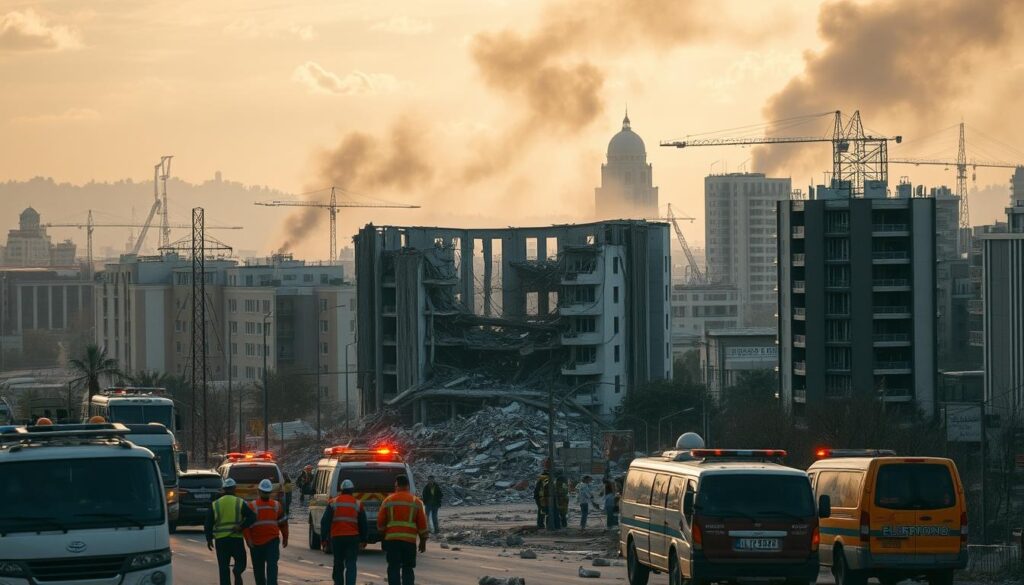
Utilizing Government Resources for Information
Government resources are great for learning about local hazards and disaster prep. For example, the Federal Emergency Management Agency (FEMA) offers Hazard Information Sheets. These sheets give detailed advice on how to prepare for and respond to different hazards.
By using these resources, I can better understand the risks in my area. I can then make effective emergency preparedness plans.
Local emergency management agencies also have important info. They share details on evacuation routes, emergency shelters, and more. I can stay updated by visiting their websites, going to community meetings, and signing up for emergency alerts.
By identifying local hazards and using government resources, I can fully grasp the risks in my area. I can then create a disaster response plan that meets my community’s needs.
Creating a Comprehensive Emergency Plan
A good emergency plan is key for disaster readiness. It’s about talking with your family about emergency prep and roles. This helps everyone know what to do.
To make a solid plan, think about a few important things. You need to list possible emergencies, set up ways to communicate, and pick a meeting spot outside your home.
Key Components of My Plan
My plan will have clear roles and responsibilities for each family member. This way, everyone knows their part in an emergency. For example, I might check the emergency kit, and my kids will know who to call.
It’s also important to stay informed about dangers in your area. Knowing about possible disasters and their signs helps you prepare better.
- Identify possible emergency scenarios
- Set up ways to communicate
- Choose a meeting spot outside your home
- Assign roles and responsibilities to family members
Involving Family Members in the Planning Process
Getting everyone involved in planning is essential. It makes sure everyone knows the plan and their part in it. I’ll talk with my family about the plan, so they understand their roles.
Working together on a plan makes us all more ready for disasters. This teamwork boosts our safety and lessens stress during emergencies.
Assembling an Emergency Kit
My emergency kit is key to my disaster survival plan. I always keep it stocked and ready. It’s a collection of essential items that help me and my family survive during and after a disaster.
Having the right supplies is vital for emergency preparedness. When I put together my kit, I focus on items that are versatile, durable, and meet our basic needs.
Essential Items I Include in My Kit
The essentials in my emergency kit include:
- Non-perishable food that is easy to prepare
- Adequate water supply (at least 1 gallon per person per day)
- A flashlight and extra batteries
- A first aid kit with bandages, antiseptic wipes, and pain relievers
- A battery-powered radio and/or a NOAA Weather Radio
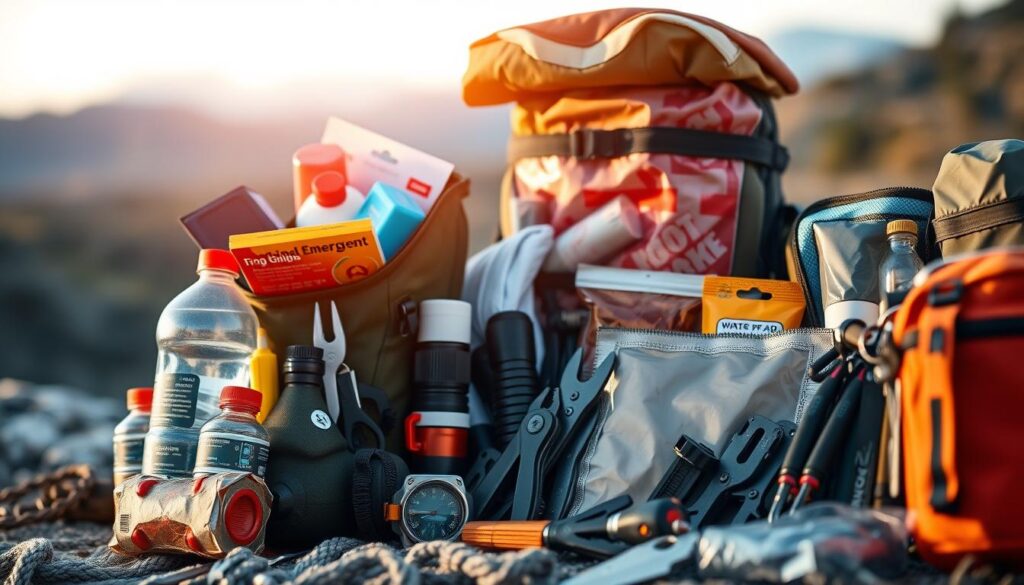
Rotating and Updating Supplies
Assembling the kit is not a one-time task; it requires regular maintenance. I check my emergency kit every 6 months to:
- Check expiration dates of food, water, and medical supplies
- Replace batteries and test equipment like flashlights and radios
- Update my kit according to any changes in my family’s needs
By regularly rotating and updating my supplies, I ensure my emergency kit stays relevant and effective. It provides me with disaster survival tips that can make a big difference in a crisis.
Developing Communication Strategies
When disaster hits, having a solid communication plan is key. It helps keep everyone informed and connected. This can turn chaos into order.
Establishing Family Communication Plans
A strong crisis management plan includes a family communication plan. Pick an out-of-area contact person for emergencies. Make sure everyone knows this person’s contact info.
It’s also important to have emergency contact details with you always.
- Choose a reliable out-of-area contact person.
- Ensure all family members have the contact information saved.
- Regularly review and update the contact information.
Utilizing Technology in Emergencies
Today, technology is a big help in disaster response strategies. Smartphones, emergency apps, and social media keep families connected during emergencies.
Here are some tips:
- Download emergency alert apps.
- Use social media to check on family members.
- Have a backup power source for devices.
Practicing My Disaster Plan
Creating a disaster plan is just the start. It’s practicing that really gets us ready for emergencies. By doing regular drills, my family and I can respond quickly if disaster strikes.
Conducting Regular Drills
Regular drills are key to being prepared. They show us where our plan might fail and make sure everyone knows their part. For example, I practice evacuating with my family using our planned route.
This is what the American Red Cross suggests in their guidelines on making a plan.
| Drill Type | Frequency | Purpose |
|---|---|---|
| Evacuation Drill | Every 6 months | To ensure all family members know the evacuation route and assembly point. |
| Communication Drill | Every 3 months | To verify that all family members can contact each other. |
Adapting to Different Scenarios
It’s important to adjust my plan for different emergencies. This way, my family and I are ready for any situation. 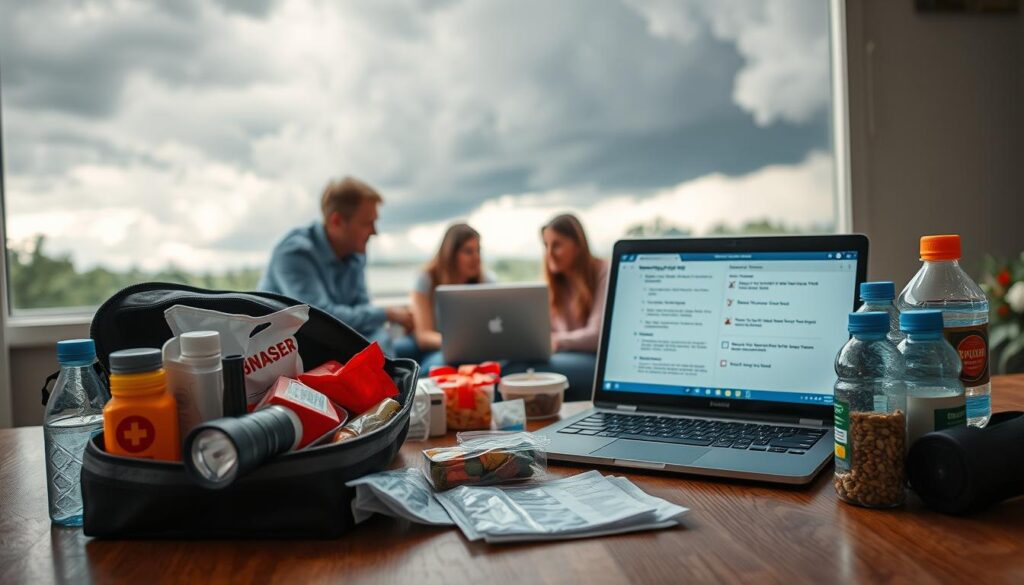
If I live in a flood area, for instance, I practice for floods. I learn the safest paths to higher ground and where to find emergency shelter.
By practicing and updating my plan, we’re all set to handle any emergency that comes our way.
Staying Informed and Updated
I make sure my family is safe by knowing about possible disasters. I keep up with the latest emergency alerts. I also know how local news helps share important info.
Reliable Sources for Emergency Alerts
Using reliable sources for emergency alerts is key. The Federal Emergency Management Agency (FEMA) App is a great tool. It sends real-time weather alerts and emergency notifications.
Key Features of the FEMA App:
| Feature | Description |
|---|---|
| Real-time Alerts | Receive timely notifications about weather conditions and emergencies. |
| Personalized Notifications | Customize alerts based on my location and specific needs. |
| Emergency Shelters | Find nearby shelters and emergency services. |
Following Local News Outlets
I also keep up with local news to know about disasters. Local news gives detailed info on weather, evacuations, and more. This helps me make safe choices for my family.
Local news outlets often provide:
- Detailed weather forecasts and warnings
- Information on evacuation routes and shelters
- Updates on the status of local emergencies
By using the FEMA App and local news, I get a full picture of disaster risks. This helps me prepare my family.
Understanding Evacuation Routes
Knowing evacuation routes is key for disaster response strategies. A good plan can save lives when disaster hits.
First, find the safest ways out of your home and area. It’s important to map out multiple escape routes. This way, you have options if the main route is blocked.
Mapping My Escape Routes
To map your escape routes, follow these steps:
- Find primary and backup escape paths from your home.
- Think about the terrain and dangers on each path.
- Choose paths that steer clear of crowded spots like bridges.
For tips on preparing your home for disasters, check out Disaster-Proof Your Home: My 7 Best.
Practicing Evacuation with My Family
After mapping your routes, practice evacuating with your family. This means:
| Practice Activity | Frequency | Purpose |
|---|---|---|
| Conducting evacuation drills | Every 6 months | To ensure all family members know the evacuation routes |
| Simulating different disaster scenarios | Annually | To prepare for various possible disasters |
Practicing evacuations helps everyone know what to do in an emergency. It also spots any weak points in your plan. Regularly reviewing and updating your plan makes you more ready for disasters.
By learning and practicing evacuation routes, you boost your disaster survival tips. This makes sure you and your family are safer.
Resources for Additional Support
As I work on my emergency plan, I find help from local groups, preparedness programs, and online forums. These sources offer valuable info, training, and help. They make my disaster prep better.
Local Organizations and Preparedness Programs
Local groups are key in disaster prep. They give training, resources, and support. For example, FEMA’s online ordering platform offers free stuff. It helps teach my family and neighbors about disaster risks and how to respond.
Some important local groups and programs I use include:
- American Red Cross
- Local emergency management agencies
- Community preparedness initiatives
These groups offer workshops, training, and materials on crisis management and disaster recovery. By joining these programs, I learn more about local risks. I also make a better emergency plan.
| Organization | Resources Offered | Contact Information |
|---|---|---|
| American Red Cross | Disaster preparedness training, emergency kits | www.redcross.org |
| FEMA | Free preparedness materials, disaster recovery information | www.fema.gov |
| Local Emergency Management Agency | Community preparedness initiatives, emergency alerts | Contact local government office |
Online Communities for Shared Learning
Online communities also help a lot with disaster prep. I can share my experiences, learn from others, and get the latest on crisis management.
Some online places I connect with include:
- Disaster preparedness forums
- Social media groups focused on emergency preparedness
- Online training courses on disaster recovery planning
By using both local resources and online communities, I build a strong support network. This network helps me get better at disaster prep and response.
Special Considerations for Vulnerable Populations
When I make my emergency plan, I think about pets, animals, and neighbors who need help. I learn what they need and add it to my plan. This makes sure everyone is ready for a disaster.
Preparing for Pets and Animals
Pets are like family to me, and their safety is key. To get ready for them, I do a few things:
- Make sure I have enough food and water for them for a week.
- Have a carrier or crate ready for evacuation.
- Find pet-friendly hotels and shelters on my evacuation path.
- Make sure they’re microchipped and wear ID tags.
For bigger animals like horses or livestock, I need a detailed plan. This includes finding safe places for them and planning for their food and care.
Assisting Elderly or Disabled Neighbors
Neighbors who are older or have disabilities might need more help in a disaster. Here’s what I can do:
- Check in with them to see if they have a plan.
- Help them make an emergency kit or a personal care plan.
- Find local resources for extra support, like transportation or shelters for people with disabilities.
By helping my neighbors, I also make my community safer. Good emergency planning means thinking about everyone’s needs. This way, we can all face and get through disasters better.
The Role of Community in Disaster Preparedness
Being ready for disasters isn’t just about personal efforts. It’s also about making our community strong. When we work together with our neighbors, we build a support system. This system helps us face and get over disasters better.
Building Relationships with Neighbors
Creating strong bonds with our neighbors is key to a resilient community. We can form a network of support that’s vital in emergencies. Here’s how I’m building these bonds:
- Introducing myself and getting to know their names and contact information.
- Organizing or participating in neighborhood gatherings to discuss disaster preparedness plans.
- Collaborating on community projects, such as creating a neighborhood watch or emergency response plan.
Together, my neighbors and I can spot our community’s weak spots. We can then plan how to fix them. For example, we might start a community emergency response team (CERT). This team will learn how to respond to disasters.
Participating in Local Preparedness Events
Joining local preparedness events is also vital. These events teach us how to get ready for and handle disasters. They’re great for meeting local emergency officials and other community folks.
Being part of these events has many benefits:
| Event Type | Benefits | Outcomes |
|---|---|---|
| Disaster drills | Practical experience in responding to disasters | Improved response times and effectiveness |
| Preparedness workshops | Knowledge on creating emergency kits and plans | Enhanced community resilience |
| Community fairs | Opportunities to meet local emergency responders | Better understanding of local resources |
By joining in these events, I stay updated on disaster response strategies. I also help make our community more resilient.
In conclusion, the role of community in disaster preparedness is vital. By forming strong bonds with neighbors and taking part in local events, we boost our community’s disaster readiness. This makes our community stronger and more resilient.
Evaluating and Improving My Plan
As I finalize my disaster preparedness plan, it’s key to regularly check and enhance it. Reviewing and practicing the emergency plan often is vital. This helps me stay ready for any disaster.
Reflecting on Past Experiences
Reflecting on past experiences helps me spot areas for improvement. I update my plan to make it better. This includes checking my emergency kit, communication plans, and evacuation routes. I use valuable tips for disaster survival.
Making Adjustments Based on Feedback
I’ll adjust my plan based on feedback from family and lessons from drills and real events. This ensures my plan stays up-to-date and effective.
By always checking and improving my plan, I can be sure I’m ready for any disaster. My family and I will stay safe in emergency situations. This shows the ongoing need for emergency preparedness.
FAQ
Why is disaster preparedness important?
Disaster preparedness is key because it helps people get ready for emergencies. It keeps them and their families safe. By having a plan, people can lessen the disaster’s impact on their community.
How do I assess the risks in my area?
To find out the risks in your area, look at local hazards and use government resources. This helps you know the dangers you face. You can also use online tools like disaster maps and emergency alerts to stay updated.
What are the key components of a good emergency plan?
A good emergency plan has important parts like evacuation routes and emergency contacts. It’s also vital to involve all family members. This way, everyone knows their role and what to do.
What are the essentials for assembling an effective emergency kit?
An effective emergency kit needs basic items like food, water, first aid, and a battery radio. Make sure to update and check your supplies regularly. This keeps them useful and relevant.
How can I stay informed and updated on possible disasters?
To stay informed, use trusted sources like the National Weather Service and local news. Sign up for emergency alerts from your local government or weather service. This way, you get updates quickly.
What are some special considerations for vulnerable populations?
People who are elderly or disabled need extra help during disasters. Make sure you have a plan for their care and evacuation. You can also contact local groups that help vulnerable people.
How can I evaluate and improve my disaster plan?
To improve your plan, think about past experiences and make changes. Do drills and review your plan with your family. This keeps your plan up-to-date and effective.
What role does the community play in disaster preparedness?
Communities are key in disaster preparedness. They help by building relationships, joining local events, and sharing resources. Together, communities can be stronger and support each other during emergencies.
How often should I update my emergency kit and plan?
Update your emergency kit and plan at least twice a year, or as needed. This keeps your supplies and plan relevant and effective.
What are some effective disaster response strategies?
Good disaster response includes having a clear plan, staying informed, and being ready to adapt. Prioritize crisis management and preparedness to reduce disaster impact.
How can I prepare for pets and animals during disasters?
Include pets in your emergency plan and have a plan for their care or evacuation. Prepare a pet emergency kit with food, water, and medication. This ensures their safety during disasters.

